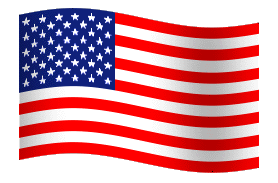
Betsy Ross and the American Flag
Timeline of Flag Desecration Issues
This timeline from Committee on the Judiciary
1777: Approval of Flag Design — The Continental Congress approved the stars and stripes design for the new American flag on June 14, 1777 (Flag Day) in order to designate and protect U.S. ships at sea. However, the flag did not become a widely used or generally popular symbol until after the Civil War.
1897: Adoption of State Flag Desecration Statutes — By the late 1800's an organized flag protection movement was born in reaction to perceived commercial and political misuse of the flag. After supporters failed to obtain federal legislation, Illinois, Pennsylvania, and South Dakota became the first States to adopt flag desecration statutes. By 1932, all of the States had adopted flag desecration laws.
In general, these State laws outlawed: (i) placing any kind of marking on the flag, whether for commercial, political, or other purposes; (ii) using the flag in any form of advertising; and (iii) publicly mutilating, trampling, defacing, defiling, defying or casting contempt, either by words or by act, upon the flag. Under the model flag desecration law, the term "flag" was defined to include any flag, standard, ensign, or color, or any representation of such made of any substance whatsoever and of any size that evidently purported to be said flag or a picture or representation thereof, upon which shall be shown the colors, the stars and stripes in any number, or by which the person seeing the same without deliberation may believe the same to represent the flag of the U.S.
1907: Halter v. Nebraska (205 U.S. 34) — The Supreme Court held that although the flag was a federal creation, the States' had the authority to promulgate flag desecration laws under their general police power to safeguard public safety and welfare.
Halter involved a conviction of two businessmen selling "Stars and Stripes" brand beer with representations of the U.S. flag affixed to the labels. The defendants did not raise any First Amendment claim.
1931: Stromberg v. California (283 U.S. 359) — The Supreme Court found that a State statute prohibiting the display of a "red flag" as a sign of opposition to organized government unconstitutionally infringed on the defendant's First Amendment rights. Stromberg represented the Court's first declaration that "symbolic speech" was protected by the First Amendment.
1942: Federal Flag Code (36 U.S.C. 171 et seq.) — On June 22, 1942, President Roosevelt approved the Federal Flag Code, providing for uniform guidelines for the display and respect shown to the flag. The Flag Code does not prescribe any penalties for non-compliance nor does it include any enforcement provisions, rather it functions simply as a guide for voluntary civilian compliance.
1943: West Virginia Board of Education v. Barnette (319 U.S. 624) — The Supreme Court held that public school children could not be compelled to salute the U.S. flag. In a now famous passage, Justice Jackson highlighted the importance of freedom of expression under the First Amendment:
Freedom to differ is not limited to things that do not matter much. That would be a mere shadow of freedom. The test of its substance is the right to differ as to things that touch the heart of the existing order. If there is any fixed star in our constitutional constellation it is that no official, high or petty, can prescribe what shall be orthodox in politics, nationalism, religion or other matters of opinion.
1968: Adoption of Federal Flag Desecration Law (18 U.S.C. 700 et seq.) — Congress approved the first federal flag desecration law in the wake of a highly publicized Central Park flag burning incident in protest of the Vietnam War. The federal law made it illegal to "knowingly" cast "contempt" upon "any flag of the United States by publicly mutilating, defacing, defiling, burning or trampling upon it." The law defined flag in an expansive manner similar to most States.
1969: Street v. New York (394 U.S. 576) — The Supreme Court held that New York could not convict a person based on his verbal remarks disparaging the flag. Street was arrested after he learned of the shooting of civil rights leader James Meredith and reacted by burning his own flag and exclaiming to a small crowd that if the government could allow Meredith to be killed, "we don't need no damn flag." The Court avoided deciding whether flag burning was protected by the First Amendment, and instead overturned the conviction based on Street's oral remarks. In Street, the Court found there was not a sufficient governmental interest to warrant regulating verbal criticism of the flag.
1974: Smith v. Goguen (415 U.S. 94) — The Supreme Court held that Massachusetts could not prosecute a person for wearing a small cloth replica of the flag on the seat of his pants based on a State law making it a crime to publicly treat the flag of the United States with "contempt." The Massachusetts statute was held to be unconstitutionally "void for vagueness."
1974: Spence v. Washington (418 U.S. 405) — The Supreme Court held that the State of Washington could not convict a person for attaching removable tape in the form of a peace sign to a flag. The defendant had attached the tape to his flag and draped it outside of his window in protest of the U.S. invasion of Cambodia and the Kent State killings. The Court again found under the First Amendment there was not a sufficient governmental interest to justify regulating this form of symbolic speech. Although not a flag burning case, this represented the first time the Court had clearly stated that protest involving the physical use of the flag should be seen as a form of protected expression under the First Amendment.
1970-1980: Revision of State Flag Desecration Statutes — During this period legislatures in some 20 States narrowed the scope of their flag desecration laws in an effort to conform to perceived Constitutional restrictions under the Street, Smith, and Spence cases and to more generally parallel the federal law (i.e., focusing more specifically on mutilation and other forms of physical desecration, rather than verbal abuse or commercial or political misuse).
1989: Texas v. Johnson (491 U.S. 397) — The Supreme Court upheld the Texas Court of Criminal appeals finding that Texas law — making it a crime to "desecrate" or otherwise "mistreat" the flag in a way the "actor knows will seriously offend one or more persons" — was unconstitutional as applied. This was the first time the Supreme Court had directly considered the applicability of the First Amendment to flag burning.
Gregory Johnson, a member of the Revolutionary Communist Party, was arrested during a demonstration outside of the 1984 Republican National Convention in Dallas after he set fire to a flag while protestors chanted "America, the red, white, and blue, we spit on you." In a 5-4 decision authored by Justice Brennan, the Court first found that burning the flag was a form of symbolic speech subject to protection under the First Amendment. The Court also determined that under United States v. O'Brien, 391 U.S. 367 (1968), since the State law was related to the suppression of freedom of expression, the conviction could only be upheld if Texas could demonstrate a "compelling" interest in its law. The Court next found that Texas' asserted interest in "protecting the peace" was not implicated under the facts of the case. Finally, while the Court acknowledged that Texas had a legitimate interest in preserving the flag as a "symbol of national unity," this interest was not sufficiently compelling to justify a "content based" legal restriction (i.e., the law was not based on protecting the physical integrity of the flag in all circumstances, but was designed to protect it from symbolic protest likely to cause offense to others).
1989: Revision of Federal Flag Desecration Statute — Pursuant to the Flag Protection Act of 1989, Congress amended the 1968 federal flag desecration statute in an effort to make it "content neutral" and conform to the Constitutional requirements of Johnson. As a result, the 1989 Act sought to prohibit flag desecration under all circumstances by deleting the statutory requirement that the conduct cast contempt upon the flag and narrowing the definition of the term "flag" so that its meaning was not based on the observation of third parties.
1990: United States v. Eichman (496 U.S. 310) — Passage of the Flag Protection Act resulted in a number of flag burning incidents protesting the new law. The Supreme Court overturned several flag burning convictions brought under the Flag Protection Act of 1989. The Court held that notwithstanding Congress' effort to adopt a more content neutral law, the federal law continued to be principally aimed at limiting symbolic speech.
1990: Rejection of Constitutional Amendment — Following the Eichman decision, Congress considered and rejected a Constitutional Amendment specifying that "the Congress and the States have the power to prohibit the physical desecration of the flag of the United States." The amendment failed to muster the necessary two-thirds Congressional majorities, as it was supported by only a 254–177 margin in the House (290 votes were necessary) and a 58–42 margin in the Senate (67 votes were necessary).


